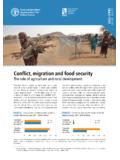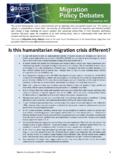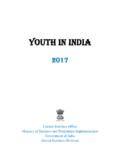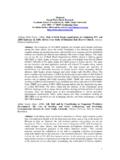Transcription of MIGRATION AND YOUTH - Global Migration Group
1 1 MIGRATION AND YOUTH : CHALLENGES AND OPPORTUNITIES* E x e c u t i v e S u m m a r y UN Photo/ Kibae Park 2 his Thematic Report by the Global MIGRATION Group (GMG) offers a comprehensive overview of the many facets of YOUTH MIGRATION , from contexts of rural marginalization and environmental degradation where many young migrants begin their journey to the challenges they face in countries of destination, such as realising their rights, accessing decent work and social protection. It discusses a range of specific issues, ranging from employment to gender to health, education and participation. The report is intended as an action-oriented contribution to the MIGRATION policy debate. In addition to elaborating on perspectives of 12 UN bodies with GMG membership, it also includes chapters prepared by the OECD, scholars, and non-governmental organisations devoted to YOUTH and MIGRATION issues.
2 Going beyond a rich and thorough background introduction, chapters include examples of good practices, succinct messages and concrete, forward-thinking policy options for realising the opportunities offered by YOUTH MIGRATION . YOUTH MIGRATION Today, there are approximately 232 million international migrants (this estimate includes all people living in a country or area other than that in which they were born,), according to the 2013 UN estimate of Global migrant stocks,1 of whom roughly 12 per cent are between 15 and 24 years of age. Young people comprise a considerably larger share of contemporary MIGRATION flows. Acknowledging that it remains difficult to determine drivers of MIGRATION among adolescents and YOUTH , the report notes that young people s motivations to migrate are often linked to the search for decent livelihoods due to lack of employment and/or under-employment, indecent working conditions and poor economic prospects in countries of origin.
3 Furthering education, family reunification and escaping from regions affected by war, persecution, humanitarian crises or natural disasters are also important motives for MIGRATION . In many cases, gender-based discrimination, including gender-based violence or restrictions on women s rights, is another reason for MIGRATION . T 3 WHY ADOLESCENTS AND YOUTH ? The report focuses on migrant adolescents and YOUTH because they represent a specific category of migrants whose unique needs, rights and challenges are not addressed as part of the larger MIGRATION policy debate. It refers to YOUTH /adolescent migrants as persons aged 15-24, those the United Nations (UN) defines as YOUTH without prejudice to other definitions by Member States. 2 The report on occasion references groups other than those aged 15-to-24.
4 Several chapters include discussions of internal as well as international MIGRATION issues, and certain chapters also address YOUTH /adolescents affected by MIGRATION in other ways, such as children born to immigrant parents in destination countries. Adolescence and YOUTH are pivotal stages of human development, during which young people make the transition from the dependence of childhood to the independence of adulthood. During adolescence the investments and gains of early and middle childhood come to fruition; however, these gains must be sustained and consolidated to ensure an effective transition into It is also a period during which social, economic, biological and other events occur that set the stage for adult life. A positive MIGRATION experience during this age period can set young migrants on a successful path toward capitalising on their accomplishments and developing economic and social assets for their future.
5 However, if MIGRATION takes place during these years and the circumstances are negative, the experience can have particularly dire and traumatizing consequences for adolescents short- and long-term future. Not only can they lose a valuable opportunity for full human development, but their countries of birth and destination stand to lose an enormous potential contribution to social, economic and cultural development. Getting today s policies right concerning adolescent and YOUTH migrants also means planning for the future. By 2025 when the Global population is expected to reach 8 billion countries around the globe will be impacted by demographic changes evolving today. The majority of the next billion people will be born in low- and middle-income While developed countries are simultaneously facing low fertility rates, ageing populations and declining workforces, many less developed countries in sub-Saharan Africa and South Asia continue experiencing higher birth rates and a significant YOUTH bulge.
6 5 The former need workers while growing numbers of young 4 people in less-developed countries need jobs. MIGRATION will be a major factor in response to those trends. OPPORTUNITIES FOR ADOLESCENT AND YOUTH MIGRANTS Adolescent and YOUTH migrants are generally resourceful, resilient, adaptable to new environments and able to learn and speak new languages. Many have skills and qualifications and are familiar with new technologies. For many young people MIGRATION represents an important step toward achieving a sustainable life for themselves and their families. For others MIGRATION is a way to escape from chronic poverty, violence, gender-based discrimination or the effects of climate change. In host communities, equality of treatment and opportunity allows migrants to contribute as productive members of communities, as workers, students, entrepreneurs, artists, and consumers.
7 If MIGRATION becomes a productive and empowering experience and opens up new opportunities, young people can gain more skills through education and/or work experience and earn higher wages, allowing them to support their families and contribute to the development of their communities of origin as well as the societies where they live and work. Especially for young women, MIGRATION can also be a socially empowering experience. As the recipient of remittances or as a breadwinner in a new country, they may gain decision-making power and they may experience greater rights and personal autonomy and be able to participate in political processes. In all countries, a conducive policy environment can tap into young people s energy, propensity to innovate and familiarity with new technologies to revitalise economies.
8 The young and mobile represent human resources and development potential for both the countries where they were born and those to which they migrate. SPECIFIC NEEDS AND VULNERABILITIES OF ADOLESCENT AND YOUTH MIGRANTS Risks faced by migrants are exacerbated in the case of adolescents and YOUTH . Young migrants are more vulnerable when, in combination with their age and stage of life, they experience isolation, exclusion, discrimination and insecurity. Moreover, in the MIGRATION process young people can lose their social networks and may also be without parents or family members to provide guidance and care. Young people may be 5 particularly affected by xenophobia and discrimination and suffer further marginalization due to lack of fluency in the local language, new and different cultural norms and lack of information about laws and regulations.
9 Young migrants are particularly vulnerable to risks when they are in irregular situations and face threats of exploitation, trafficking, exclusion, detection, detention and deportation. Adolescent and YOUTH migrants, especially girls, are vulnerable to human rights violations such as child marriage, sexual exploitation, violence and unpaid labour. To overcome these risks and to enhance their development potential and their contributions to their countries of origin and destination, young migrants need to be able to realise their rights, such as the right and access to education, health care, non-discrimination, including in employment, participation in decision-making, and family life. YOUTH , MIGRATION AND THE DEVELOPMENT AGENDA In framing this report, GMG agencies recognized that MIGRATION is not a panacea for achieving development, nor can promoting MIGRATION substitute for appropriate public policies on development or on governing MIGRATION .
10 However, it is a Global reality that, if addressed wisely, MIGRATION can benefit all concerned and involve adolescents and YOUTH . GMG members share the premise that the MIGRATION experience can be beneficial to adolescents and YOUTH if and only if MIGRATION policies are anchored in a system that protects young migrants human and labour rights. With the approach of 2015, the target year for achieving the MDGs (Millennium Development Goals) set in 2000, Global debates now revolve around establishing development goals for the post-2015 era. The UN post-2015 Task Team acknowledged MIGRATION and mobility as important enablers for inclusive and sustainable development and Global consultations on population dynamics also strongly urged integrating MIGRATION into the new development framework. This report contributes to the discussions about the post-2015 agenda through its comprehensive and exclusive focus on MIGRATION as it affects adolescents and YOUTH .







